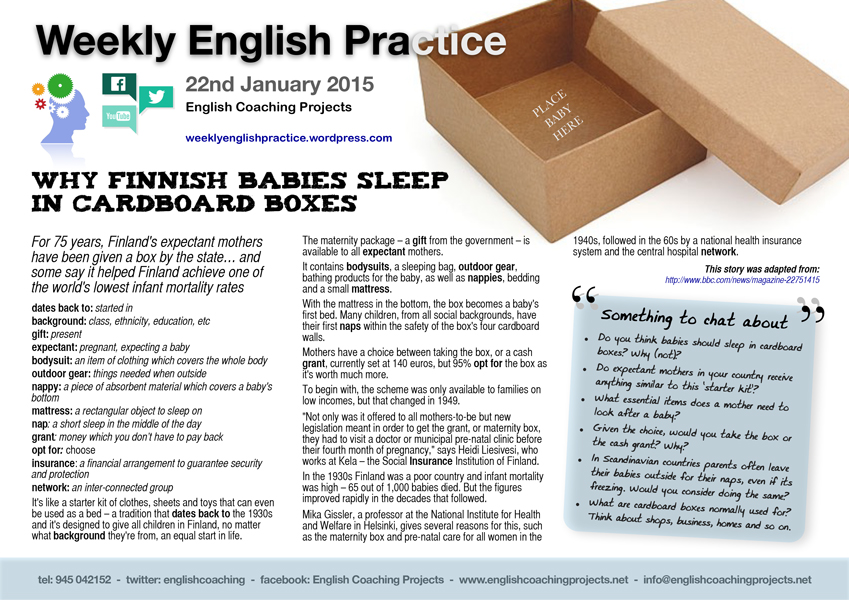Click on the image to download the pdf
Why Finnish babies sleep in cardboard boxes
Vocabulary. Read and check you understand this before you read and listen to the article:
dates back to: started in
background: class, ethnicity, education, etc
gift: present
expectant: pregnant, expecting a baby
bodysuit: an item of clothing which covers the whole body
outdoor gear: things needed when outside
nappy: a piece of absorbent material which covers a baby’s bottom
mattress: a rectangular object to sleep on
nap: a short sleep in the middle of the day
grant: money which you don’t have to pay back
opt for: choose
insurance: a financial arrangement to guarantee security and protection
network: an inter-connected group
For 75 years, Finland’s expectant mothers have been given a box by the state… and some say it helped Finland achieve one of the world’s lowest infant mortality rates.
It’s like a starter kit of clothes, sheets and toys that can even be used as a bed – a tradition that dates back to the 1930s and it’s designed to give all children in Finland, no matter what background they’re from, an equal start in life.
The maternity package – a gift from the government – is available to all expectant mothers.
It contains bodysuits, a sleeping bag, outdoor gear, bathing products for the baby, as well as nappies, bedding and a small mattress.
With the mattress in the bottom, the box becomes a baby’s first bed. Many children, from all social backgrounds, have their first naps within the safety of the box’s four cardboard walls.
Mothers have a choice between taking the box, or a cash grant, currently set at 140 euros, but 95% opt for the box as it’s worth much more.
To begin with, the scheme was only available to families on low incomes, but that changed in 1949.
“Not only was it offered to all mothers-to-be but new legislation meant in order to get the grant, or maternity box, they had to visit a doctor or municipal pre-natal clinic before their fourth month of pregnancy,” says Heidi Liesivesi, who works at Kela – the Social Insurance Institution of Finland.
In the 1930s Finland was a poor country and infant mortality was high – 65 out of 1,000 babies died. But the figures improved rapidly in the decades that followed.
Mika Gissler, a professor at the National Institute for Health and Welfare in Helsinki, gives several reasons for this, such as the maternity box and pre-natal care for all women in the 1940s, followed in the 60s by a national health insurance system and the central hospital network.
Something to chat (or write) about.
- Do you think babies should sleep in cardboard boxes? Why (not)?
- Do expectant mothers in your country receive anything similar to this ‘starter kit’?
- What essential items does a mother need to look after a baby?
- Given the choice, would you take the box or the cash grant? Why?
- In Scandinavian countries parents often leave their babies outside for their naps, even if its freezing. Would you consider doing the same?
- What are cardboard boxes normally used for? Think about shops, business, homes and so on.
This story was adapted from: http://www.bbc.com/news/magazine-22751415


